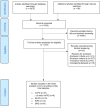Clinical outcomes in brief psychotic episodes: a systematic review and meta-analysis
- PMID: 35698876
- PMCID: PMC8581951
- DOI: 10.1017/S2045796021000548
Clinical outcomes in brief psychotic episodes: a systematic review and meta-analysis
Abstract
Aims: Patients with brief psychotic episodes (BPE) have variable and fluctuating clinical outcomes which challenge psychiatric care. Our meta-analysis aims at providing a comprehensive summary of several clinical outcomes in this patient group.
Methods: A multistep systematic PRISMA/MOOSE-compliant literature search was performed for articles published from inception until 1st March 2021. Web of Science database was searched, complemented by manual search of original articles reporting relevant outcomes (psychotic recurrence, prospective diagnostic change or stability, remission, quality of life, functional status, mortality and their predictors) for patients diagnosed with acute and transient psychotic disorders (ATPD), brief psychotic disorders (BPD), brief intermittent psychotic symptoms (BIPS) and brief limited intermittent psychotic symptoms (BLIPS). Random-effects methods and Q-statistics were employed, quality assessment with Newcastle-Ottawa Scale, assessment of heterogeneity with I2 index, sensitivity analyses (acute polymorphic psychotic disorders, APPD) and multiple meta-regressions, assessment of publication bias with funnel plot, Egger's test and meta-regression (psychotic recurrence and sample size).
Results: A total of 91 independent articles (n = 94 samples) encompassed 37 ATPD, 24 BPD, 19 BLIPS and 14 BIPS samples, totalling 15 729 individuals (mean age: 30.89 ± 7.33 years, mean female ratio: 60%, 59% conducted in Europe). Meta-analytical risk of psychotic recurrence for all BPE increased from 15% (95% confidence interval (CI) 12-18) at 6 months, 25% (95% CI 22-30) at 12 months, 30% (95% CI 27-33) at 24 months and 33% (95% CI 30-37) at ⩾36 months follow-up, with no differences between ATPD, BPD, BLIPS and BIPS after 2 years of follow-up. Across all BPE, meta-analytical proportion of prospective diagnostic stability (average follow-up 47 months) was 49% (95% CI 42-56); meta-analytical proportion of diagnostic change (average follow-up 47 months) to schizophrenia spectrum psychoses was 19% (95% CI 16-23), affective spectrum psychoses 5% (95% CI 3-7), other psychotic disorders 7% (95% CI 5-9) and other (non-psychotic) mental disorders 14% (95% CI 11-17). Prospective diagnostic change within APPD without symptoms of schizophrenia was 34% (95% CI 24-46) at a mean follow-up of 51 months: 18% (95% CI 11-30) for schizophrenia spectrum psychoses and 17% (95% CI 10-26) for other (non-psychotic) mental disorders. Meta-analytical proportion of baseline employment was 48% (95% CI 38-58), whereas there were not enough data to explore the other outcomes. Heterogeneity was high; female ratio and study quality were negatively and positively associated with risk of psychotic recurrence, respectively. There were no consistent factor predicting clinical outcomes.
Conclusions: Short-lived psychotic episodes are associated with a high risk of psychotic recurrences, in particular schizophrenia spectrum disorders. Other clinical outcomes remain relatively underinvestigated. There are no consistent prognostic/predictive factors.
Keywords: ATPD; BPD; brief psychotic episode; psychosis.
Conflict of interest statement
PFP received honoraria or grant fees from Lundbeck, Angelini and Menarini in the past 36 months outside the current work.
Figures



Similar articles
-
Prognosis of Brief Psychotic Episodes: A Meta-analysis.JAMA Psychiatry. 2016 Mar;73(3):211-20. doi: 10.1001/jamapsychiatry.2015.2313. JAMA Psychiatry. 2016. PMID: 26764163
-
Diagnostic Stability of ICD/DSM First Episode Psychosis Diagnoses: Meta-analysis.Schizophr Bull. 2016 Nov;42(6):1395-1406. doi: 10.1093/schbul/sbw020. Epub 2016 Mar 15. Schizophr Bull. 2016. PMID: 26980142 Free PMC article.
-
Clinical outcomes in individuals at clinical high risk of psychosis who do not transition to psychosis: a meta-analysis.Epidemiol Psychiatr Sci. 2022 Jan 19;31:e9. doi: 10.1017/S2045796021000639. Epidemiol Psychiatr Sci. 2022. PMID: 35042573 Free PMC article.
-
The predictive validity and outcome of ICD-10 and DSM-5 short-lived psychotic disorders: a review and meta-analysis.Eur Arch Psychiatry Clin Neurosci. 2022 Oct;272(7):1157-1168. doi: 10.1007/s00406-021-01356-7. Epub 2022 Jan 6. Eur Arch Psychiatry Clin Neurosci. 2022. PMID: 34988647 Review.
-
Association of Schizophrenia Spectrum Disorders and Violence Perpetration in Adults and Adolescents From 15 Countries: A Systematic Review and Meta-analysis.JAMA Psychiatry. 2022 Feb 1;79(2):120-132. doi: 10.1001/jamapsychiatry.2021.3721. JAMA Psychiatry. 2022. PMID: 34935869 Free PMC article.
Cited by
-
Preventing psychosis in people at clinical high risk: an updated meta-analysis by the World Psychiatric Association Preventive Psychiatry section.Mol Psychiatry. 2025 Jun;30(6):2773-2782. doi: 10.1038/s41380-025-02902-8. Epub 2025 Feb 14. Mol Psychiatry. 2025. PMID: 39953286 Free PMC article.
-
Can Non-specific Blood Inflammatory Biomarkers Predict Recovery in Acute Transient Psychotic Disorder? A Prospective Observational Study.Indian J Psychol Med. 2025 Feb 14:02537176251317648. doi: 10.1177/02537176251317648. Online ahead of print. Indian J Psychol Med. 2025. PMID: 39957793 Free PMC article.
-
Timing of antipsychotics and benzodiazepine initiation during a first episode of psychosis impacts clinical outcomes: Electronic health record cohort study.Front Psychiatry. 2022 Sep 23;13:976035. doi: 10.3389/fpsyt.2022.976035. eCollection 2022. Front Psychiatry. 2022. PMID: 36213895 Free PMC article.
-
The Translational Future of Stress Neurobiology and Psychosis Vulnerability: A Review of the Evidence.Curr Neuropharmacol. 2024;22(3):350-377. doi: 10.2174/1570159X21666230322145049. Curr Neuropharmacol. 2024. PMID: 36946486 Free PMC article. Review.
-
Acute Schizophrenia-like Psychotic Disorder Against the Background of COVID-19.Medicina (Kaunas). 2025 Feb 8;61(2):298. doi: 10.3390/medicina61020298. Medicina (Kaunas). 2025. PMID: 40005415 Free PMC article.
References
-
- Aadamsoo K, Saluveer E, Kueuenarpuu H, Vasar V and Maron E (2011) Diagnostic stability over 2 years in patients with acute and transient psychotic disorders. Nordic Journal of Psychiatry 65, 381–388. - PubMed
-
- Abe T, Otsuka K and Kato S (2006) Long-term clinical course of patients with acute polymorphic psychotic disorder without symptoms of schizophrenia. Psychiatry and Clinical Neurosciences 60, 452–457. - PubMed
-
- Alvarez-Jimenez M, O'Donoghue B, Thompson A, Gleeson JF, Bendall S, Gonzalez-Blanch C, Killackey E, Wunderink L and McGorry PD (2016) Beyond clinical remission in first episode psychosis: thoughts on antipsychotic maintenance vs. guided discontinuation in the functional recovery era. CNS Drugs 30, 357–368. - PubMed
-
- American Psychiatric Association (2013) Diagnostic and Statistical Manual of Mental Disorders: DSM-5. Arlington, VA: American Psychiatric Association.
-
- Bjorkenstam E, Bjorkenstam C, Hjern A, Reutfors J and Boden R (2013) A five year diagnostic follow-up of 1840 patients after a first episode non-schizophrenia and non-affective psychosis. Schizophrenia Research 150, 205–210. - PubMed
Publication types
MeSH terms
LinkOut - more resources
Full Text Sources
Medical

